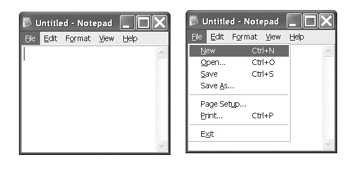Pressing Key Combinations
To use a key combination, you typically hold down the modifier key or keys while you press the alphanumeric key. For example, to issue a Print command, you press [Ctrl] and hold it down, press and release [P] , and then release [Ctrl] . To press [Ctrl] - [Shift] - [M] , you press and hold down [Ctrl] and [Shift] together while you press [M] .
[Alt] works this way as well, either in combinations or on its own, but you can also press [Alt] and release it before pressing the alphanumeric key. Pressing the [Alt] key makes Windows put the focus on the first item in the menu bar, which is typically the File menu. When you press the access key (the underlined letter), Windows activates that menu. For example, when you press [W] , Windows activates the W indow menu in many applications.
Once the menu is open , you can invoke a command on it by pressing the command s access key without pressing [Alt] again. In many applications, most of the frequently used commands have access keys. But because each access key needs to be unique for best effect, some less frequently used commands have either no access key or an unintuitive access key.
Access keys are also known as mnemonics because they frequently use the beginning letter or a key letter of the command. For example, the access key for the Save command on the File menu in standard Windows applications is S (the first letter), and the access key for the Exit command is X (the first sound in the word exit ).
If two or more commands on the same menu use the same access key, press the key once to select the first command; then press again to select the next command. When you ve reached the command you want, press [Enter] to invoke it. Figure 1-3 illustrates the process with a regular access key.

Figure 1-3: Using an [Alt] keyboard shortcut most effectively: press [Alt] to activate the first item on the menu bar (left), press the access key to display the menu (right), and then press the access key for the command.
EAN: 2147483647
Pages: 117